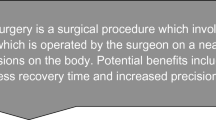Abstract
Background
Robotic surgery is used in several surgical procedures with limited evidence of clinical benefit. In some jurisdictions, the demand for robotic surgery may have been fueled by public perception of this novel technology. Therefore, we sought to investigate the public’s perception of robotic surgery.
Study design
We conducted a cross-sectional survey using a series of vignette-associated questions designed to examine the public’s perception of robotic surgery. Eligible participants were recruited through Amazon Mechanical Turk’s system and randomized to one of two pairs of vignettes: laparoscopic surgery compared to (1) robotic surgery, or (2) “novel surgical technology” (without using the term “robotic”). Outcomes of interest were anticipated postoperative outcomes using the surgical fear questionnaire, procedure preference, perception of error, trust, and competency of the surgeon.
Results
The survey included 362 respondents; 64.1% were male with median age of 53 years. There were no differences in the distribution of responses of the questionnaire based on use of the term “robotic” or “novel surgical technology”; therefore, the two cohorts were combined to examine perception of robotic compared to laparoscopic surgery. More respondents feared outcomes of robotic surgery than laparoscopic surgery (78.2% vs 14.9%, p < 0.001). Participants preferred laparoscopic to robotic surgery (64.4% vs 35.6%, p < 0.001).
Conclusion
The public fears recovery after robotic surgery and prefers laparoscopic surgery. The propagation of robotic surgery is unlikely based on public demand and may be more related to institutional or surgeon perceptions. Surgeons who provide robotic surgery should ensure their patients are comfortable with and understand this technology.



Similar content being viewed by others
References
Muaddi H, Hafid ME, Choi WJ, Lillie E, de Mestral C, Nathens A et al (2020) Clinical outcomes of robotic surgery compared to conventional surgical approaches (laparoscopic or open). Ann Surg. https://doi.org/10.1097/SLA.0000000000003915
Boys JA, Alicuben ET, DeMeester MJ, Worrell SG, Oh DS, Hagen JA et al (2016) Public perceptions on robotic surgery, hospitals with robots, and surgeons that use them. Surg Endosc 30:1310–1316
Amazon Mechanical Turk (2020) Amazon mechanical turk (MTurk)
Paolacci G, Chandler J, Ipeirotis PG (2010) Running experiments on amazon mechanical turk. Judgm Decis Mak 5(5):411–9
Theunissen M, Peters ML, Schouten EGW, Fiddelers AAA, Willemsen MGA, Pinto PR et al (2014) Validation of the surgical fear questionnaire in adult patients waiting for elective surgery. PLoS ONE. https://doi.org/10.1371/journal.pone.0100225
Theunissen M, Jonker S, Schepers J, Nicolson NA, Nuijts R, Gramke HF et al (2018) Validity and time course of surgical fear as measured with the surgical fear questionnaire in patients undergoing cataract surgery. PLoS ONE. https://doi.org/10.1371/journal.pone.0201511
Fiske ST, Cuddy AJC, Glick P, Xu J (2002) A model of (often mixed) stereotype content: competence and warmth respectively follow from perceived status and competition. J Pers Soc Psychol 82:878–902
Dugan E, Trachtenberg F, Hall MA (2005) Development of abbreviated measures to assess patient trust in a physician, a health insurer, and the medical profession. BMC Health Serv Res 2005. https://doi.org/10.1186/1472-6963-5-64
Qualtrics (2020) Qualtrics software. 2005
Dixon PR, Grant RC, Urbach DR (2015) The impact of marketing language on patient preference for robot-assisted surgery. Surg Innov 22:15–19
Funding
This study was supported by the Surgical Innovation Program at the Ontario Ministry of Health and Long-Term Care. HM salary support was provided by the Physician Services Incorporated Research Trainee Fellowship and the Canadian Institute of Health Research Vanier Scholarship.
Author information
Authors and Affiliations
Contributions
Conception and design: HM, PK, XZ, and GL. Acquisition of data: HM and XZ. Drafting of the article: HM. Final approval: All. Access to data: All. Accountability for all aspects of the work: All.
Corresponding author
Ethics declarations
Disclosures
Drs. Hala Muaddi, Xian Zhao, Geoffrey Leonardelli, Charles de Mestral, Avery Nathens, Therese Stukel, Matthew Guttman and Paul Karanicolas have no conflicts of interest or financial ties to disclose.
Additional information
Publisher's Note
Springer Nature remains neutral with regard to jurisdictional claims in published maps and institutional affiliations.
Supplementary Information
Below is the link to the electronic supplementary material.
Rights and permissions
About this article
Cite this article
Muaddi, H., Zhao, X., Leonardelli, G.J. et al. Fear of innovation: public’s perception of robotic surgery. Surg Endosc 36, 6076–6083 (2022). https://doi.org/10.1007/s00464-022-09011-5
Received:
Accepted:
Published:
Issue Date:
DOI: https://doi.org/10.1007/s00464-022-09011-5




